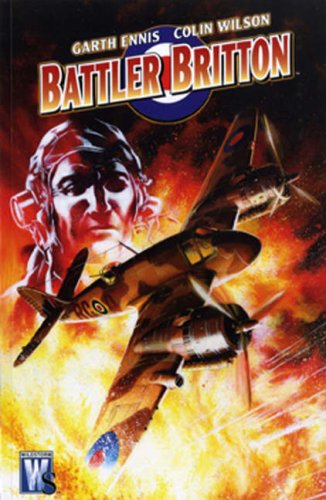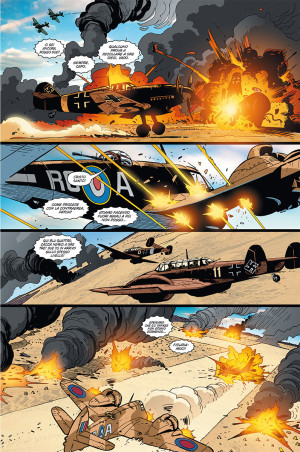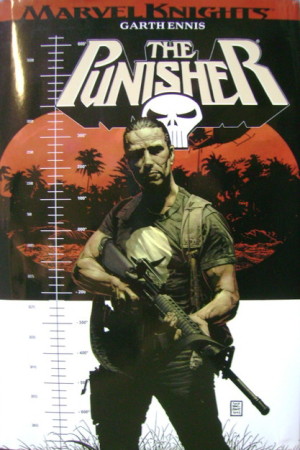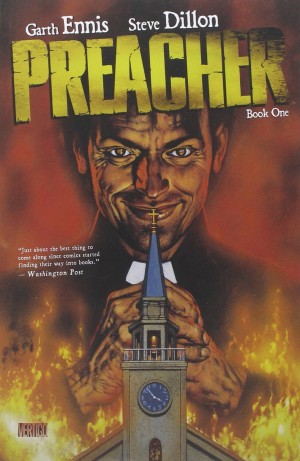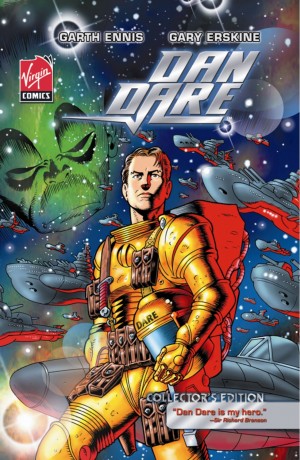Review by Jamie McNeil
Garth Ennis clearly has a soft spot for the old war stories contained in British anthology titles like the now defunct Battle. In his opening foreword he points out that the British comics have been woefully neglected and un-curated. As a result, a number of classic stories dwell only in nostalgia. Nostalgia is often a deceptive lover and while some stories are really good and culturally important to the history of the British Isles (Charley’s War please stand up!), others were only ever popular because they were products of the time and era they were written in. We have fond memories of reading them ergo they are good. Obviously not always the case, and Ennis’s affection for the old Battler Britton material proves that.
World War II Air Force Wing Commander Robert Hereward ‘Battler’ Britton first appeared in 1956 courtesy of Mike Butterworth and Geoff Campion, appearing in various anthologies until finally fading away. At some point DC purchased the rights for old Battler, and in 2006 Garth Ennis was handed the assignment that allowed Battler to take to the skies again. The premise for Battler Britton is straight forward. Battler takes to the skies, pummels Nazi pilots, runs into a bit of a tight spot, rallies, then gives the Jerries another beating. Over the years the stories became more hard-edged and less puffed up with the bravado of the victors, Ennis and artist Colin Wilson honouring the latter with more or less exactly the same format.
As part of an Allied operation Battler leads his 399 squadron into the deserts of North Africa to join US squadron the 107th and whip them into shape, before Rommel runs rough-shod over everyone to join Hitler’s armies in Europe. Sounds simple enough, but first Britton has to stop the Brits and Yanks from generally fighting and undermining each other and get them pointed at the Nazis. As far as plot goes, that’s it. Ennis wanted to introduce Battler to a generation before the old flying ace was forgotten and that’s exactly what he’s done. His writing and Colin Wilson’s artwork capture the essence of Battler Britton in every way, and by the standard of previous Battler Britton stories it’s quite good. Unfortunately that’s where the problem lies.
Battler Britton, even with talents like Ennis and Wilson, is now completely out of its time in every way. The narrative suited the years after the war because it was still relatively fresh in people’s minds. It’s also what the strict regulating bodies permitted – an indefatigably British hero. The style of writing is clunky and Ennis is far too skilled to get away with that. Wilson’s artwork is classic, but it is hard to follow the highly detailed aircraft even in colour. Rather than modernising the strip, the colour just enforces the notion it is out of date. The attitudes of those times are so different from the sense of self-entitlement so prevalent now, especially since it’s now commonly diluted down to heroism. For the men in this situation it was a job to be done.
Had it continued, Ennis and Wilson are accomplished enough to have rejuvenated the series, but alas it only highlights how far comics have developed over the years. Ennis is still right. We need to look after our old comics better, if only to preserve our history and shake off this irritating notion that comics are neither real literature nor art. Despite Ennis’ and Wilson’s noble attentions, Battler Britton is better left to the confines of history.
